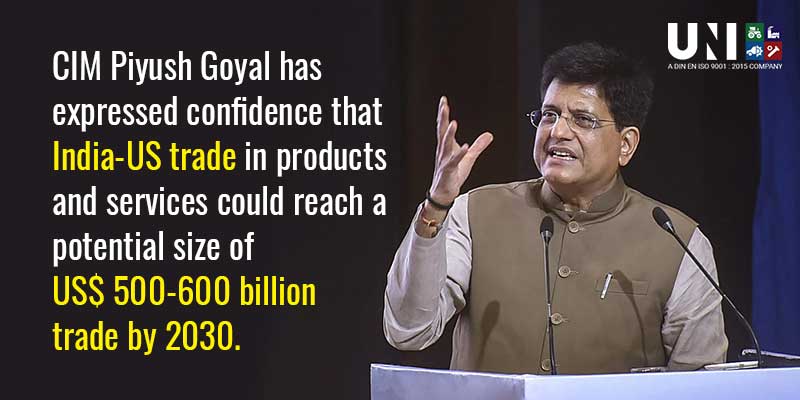Indian Commerce and Industry Minister Piyush Goyal on 12th November Saturday displayed confidence that the India-US bilateral trade in goods and services will reach USD 500-600 billion by 2030 as their relationship continues to fortify. At present, the trade between India and US stands at about USD 175 billion.
“India and the US relations are continuously improving and strengthening and today we have a bilateral trade of about USD 175 billion (exports and imports of goods and services). I believe that in the coming 7-8 years, it will be USD 500-600 billion by 2030 when our exports in goods and services will be USD 2 trillion each,”
– Goyal said.
India emerging as a driving force economy
India emerging as a driving force economy is expected to grow at 7% in 2022, according to Moody’s fresh forecast. Its trade with the world has always played a prominent role in making it a South Asian giant. Against the backdrop of multilateralism as a core strategy, India and the US have always continued to be each other’s trusted partners and their relations have been continuously improving over time.
With a shared vision of enhancing resilience, sustainability, inclusiveness, and economic growth in the Indo-Pacific region, both economies are trying to set up an all-inclusive framework of economic partnerships. The US-led, non-FTA initiative IPEF, launched in May 2021, will be working on 4 main pillars. India being a member, together with 13 other countries of the Pacific Ocean has decided to support the three pillars, which are supply chain resilience, clean energy, decarbonization and infrastructure, and taxation and anti-corruption.
Global GDP
The 14 IPEF partners represent 40% of the global GDP and 28% of the global goods and service trade. The 14 IPEF members include the US, Australia, Brunei Darussalam, Fiji, India, Indonesia, Japan, Korea, Malaysia, New Zealand, Philippines, Singapore, Thailand, and Vietnam. On whether India joins the trade pillar of the 14-member Indo-Pacific Economic Framework for Prosperity (IPEF), Goyal said it would depend on what India will get in return.
The Framework will develop flexibility, sustainability, completeness, economic growth, fairness, and competitiveness for our economies. Through IPEF, the partners aim to pay to collaboration, stability, richness, development, and peace within the region. The agenda will also offer tangible benefits that fuel economic activity and investment, promote sustainable and inclusive economic growth, and
benefit workers and consumers across the region. The 14 IPEF associates represent 40 percent of the worldwide GDP and 28 percent of global goods and services trade.While 13 out of 14 member countries have joined all four subjects- trade, supply chains, clean economy, and fair economy- under IPEF, India has chosen out of the trade pillar as of now. It has unitedwith the other three subjects.
Conclusion
Pursuant to the Aatmanirbhar Bharat Abhiyan, Make in India, and the Production-Linked Incentive (PLI) became essential stepping-stones to shaping India as an efficient, equitable, and resilient manufacturing hub. Make in India aims to encourage investment, inspire innovation, improve skill development, protect intellectual property and create best-in-class manufacturing infrastructure in the country.


